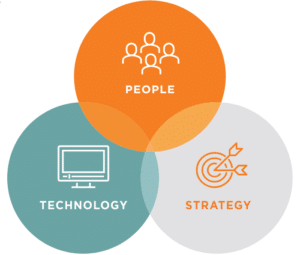How to Get More Engagement in Your Online Community
The Strategy, The People, The Technology

 A Highly Engaged Online Community Starts with the Right Foundation
A Highly Engaged Online Community Starts with the Right Foundation
We all want more engagement in our online communities. We want our communities be an essential parts of our members’ work. An engaged community can transform how an organization connects and communicates with members and employees across every stage of their journey.
But, how do you really engage community members? From successful strategies to helpful community platform features, we’ll walk through community engagement from the ground up based on our over two decades of experience. Learn how to build the right community foundation and move into the tactical, practical things you can do to encourage users to log in, engage, and return.
Whether you’re planning to create a brand new community or you’d like to get your current community more engaged, do you have the strategy, people, and technology you need? Let’s dive in!
The Strategy: Developing the Right Mindset Around Community Engagement
Great communities create value because of sustained engagement – users coming, going, and returning. But when you’re starting out, or you’re working your way up from good to great, it’s tough to know the right community engagement strategy to make logging into the community a habit for your members.
Research has shown several shared characteristics of successful communities, which require community leaders to take certain actions behind the scenes:
- Establish and share your community strategy early and often, so it’s fully discussed, vetted, and approved across your organization.
- Identify clear, actionable metrics that you’ll use to measure your community success (or warn you if you need to change tactics).
- Get buy-in for your community across the organization and secure technical, strategy, staff, and budgetary resources.
- Make sure staff responsible for the community are accountable and have the authority they need to realize strategic goals
Once you’ve set the stage, it’s vital to put the community users front-and-center of your strategy. Online community platforms should provide a curated experience for members. We’ll get into the necessary technological pieces for that later, but first, let’s explore the drivers at play with our members. Understanding the value your members are looking for informs your strategy for increasing engagement.
- What motivates members to join the community?
- Why should members return or stay longer?

What motivates members to join the community?
We know that communities create access – a gateway to resources and knowledge. And newcomers commonly cite a need to network with their peers, connect with experts, or receive specialized content. As you form your community strategy, keep these three pillars in mind: Find, connect, collaborate.
It’s all about building a destination that’s designed for engagement. Think through these questions:
- How will you make it human-focused so it’s about the users’ needs on any given day?
- How are you making them feel like they have a voice?
- Once members find the community, is it easy for them to get involved?
- Are you creating clear touchpoints that invite members to contribute?
- Have you created centralized, topic-based areas for users to get what they need?
- How will you convey value via calls-to-action (CTA) in an easy to understand way?

Why should members return to the community?
Each member may come to your community for any number of reasons – and their reasons for returning might differ throughout their membership. Your goal, therefore, is to create a wide enough set of opportunities that each member has opportunities to continuously engage throughout the member lifecycle.
In over two decades of working with online communities, we tend to see three common community personas. Each of these personas brings and receives value to/from the community in different ways – so your strategies for motivating them might look a little different:
- Consumers: Seek information, entertainment, or inspiration. Consumers are the silent observers—the lurkers and learners who absorb content without actively participating. They read posts, watch videos, and follow discussions.
- Contributors: Crave connection and recognition. Contributors are the backbone of our communities. They comment, ask questions, and share their experiences. They’re the lifeblood that keeps conversations flowing.
- Creators: Strive for self-expression and influence. are the visionaries—the ones who generate original content. They write original posts, answer questions and upload content. Their passion fuels the community’s growth.
Keeping Members Engaged in the Community
As you plan your community strategy, you should also think about self-sustaining approaches that increase the “stickiness” of your community:
- Identify and encourage super-users. Their enthusiasm and knowledge will benefit and inspire other members and the community as a whole.
- Create listening posts and polls. Create opportunities for feedback that don’t just come via email or surveys to gain insights into what matters to your members.
- Consider the member journey and how members interact with your community at different points during their career and membership lifecycle. What resources do they need now, or in the future?
- Organize your community around topics built for users’ roles and interests. Point them to relevant engagement opportunities and personalize the experience for different groups. If done well, this can lead to higher satisfaction, and ultimately, more renewals and retention.
- Connect other programs to your online community, like events and webinars. The community should be a central point of engagement – where each department benefits.
- Whenever possible, personalize. Members like to feel like you know them. Avoid community churn by curating content for different types of users.
Higher Logic has two decades of expertise in online communities and engagement, and powers 2.4 billion community interactions annually. We’re here to help you from launch to maintenance with extra guidance, manpower, or support.
The People: Who Manages Your Online Community?
Every organization needs at least some dedicated management for their community. This is one common reason communities can flounder – lack of active management. Communities need somebody to take care of them. That said, most small organizations don’t need a full-time community manager – though a large organization with lots of members or complex audience segments most likely will. Community management can also be a part-time responsibility shared by several staff at your organization.
The bottom line is this: someone needs to be responsible for the community. And experience level of the person or people managing the community will have an impact. A person with more experience will need fewer hours to be highly effective, while someone new to community management will want to dedicate time to learning.
Higher Logic can help with community management! Customers who rely on our dedicated Services during their first 12 months have:
- 68% more active users than those that don’t utilize our team
- 64% more content consumed than those that don’t utilize our team
- 102% more content created than those that don’t utilize our team
If you opt to hire an in-house community manager, here are some tips for what makes a good community manager…

Finding the Right Community Manager
Community management requires a sophisticated combination of analytical skills, project management, and strategy, alongside a strong understanding of organizational goals. Strong community managers are also engaging, write well, understand community technology, and stay calm in a crisis.
What it comes down to, no matter the situation, is accountability. Someone needs to keep your community going, tend to it, and create engagement. What you put into your
online community engagement tactics is what you will get out.

Qualifications for a Good Community Manager
- Calm, cool, and collected: Communities will have their share of needs, often enjoyable, but often stressful. Your manager should not only set and moderate the policies of your community, but they should also gracefully navigate group dynamics.
- Change agent: Find someone who can navigate internal constraints, goals, and organizational structures so they can tap into vast areas of organic growth and user-led advocacy.
- Connector, not just networker: Your manager should easily engage with your users, not just at a chatty level, but with the mission of the community and goals of your organization in mind.
- Professional engaged: Look for someone who knows how to be open online but understands the legal and ethical constraints of the profession (and how your community users might feel too).
- Analytical storyteller: You need someone who can crunch the numbers, but what’s harder to find, is someone who knows how to tell a story with the data. A thinker, not just a doer.
The Technology: Finding a Community Platform That’s Built for Engagement
Community management is powered by technology. Think about your technology as the foundation on which you’ll build the destination that supports your members. Higher Logic has worked hands-on with a lot of different kinds and sizes of organizations. Through this work, we’ve seen the process of finding the right community platform comes down to three things: Alignment, Capability, and Support.
- Alignment: Why can’t I just use …?
- Capability: What functionality do I really need?
- Support: What else do I need?
Alignment
There are lots of ways to interact with your members: industry events, advisory councils, webinars, social media platforms, etc. But when it comes to building an online community, for real engagement to happen, users need to feel a high degree of comfort about their privacy, asking questions, and belonging to the space. Sharing and showcasing their expertise often gets diffused on social media platforms or open-source solutions.
We recommend using a proprietary community platform, for several reasons:
- More control: If you create your community on social media or open source solution, you’re subject to any and all of their changes, with no say, effectively building your house on rented land.
- More security: Community vendors place privacy as top priority – it’s their job. With a Facebook or LinkedIn Group, you have a limited ability to protect your members’ privacy and your own information.
- More data: On a social media platform, they gain invaluable data that your community will inevitably generate about your members and customers – you do not. If you create your own online community, you’ll have access to all that data, helping you understand your users and creating a curated experience for your users.
- More community management tools: With a community platform like Higher Logic’s, engagement tools are built in, specifically designed to help you create an
engaging experience.
Capability
If you want an engaged community, you need to build your community in the right place. When you can motivate members to consistently engage in the community, you impact
key experience metrics. The technological infrastructure of your community can help your organization achieve higher productivity, deliver more innovative programs, and improve loyalty and retention.
To choose the best online community software for you, ask yourself:
- Can the platform support your goals?
- Can the platform support multiple use cases?
- Does it have the functionality needed to accomplish what you need?
- Is it easy to customize the platform and brand it?
- Does engagement come naturally? What built in tools exist to make it engaging?
- Does the platform integrate with your user database? This could be an Association Management System (AMS) like iMIS or a Customer Relationship Management system like Salesforce.
- Can the platform provide a personalized experience for users?
- Is the community provider/vendor innovative and forward thinking?
- Do they offer any services to help you launch your community or staff it with a community manager until you can hire one?
Higher Logic can do all these things! Learn more about our community platform and supportive services.
Support
As you dive into community management, it’s helpful to work with a community vendor that regularly shares resources and best practices – as well as one that can give you additional support when you need it. Higher Logic takes this part of work seriously – we focus on helping you create sustained, long term engagement centered around expertise sharing at all levels. We host educational webinars and events, maintain a collection of helpful resources and blog posts, chat strategy on our podcast, offer a Higher Logic Users Group (HUG) where customers can learn from and connect with their peers, and provide supportive Services to give you a boost when you need it.
We’re here for you to help make your job easier, and to help your community and members be successful. Schedule a demo to learn what we can do for you!
The Tactics: Creating and Encouraging the Right Content
Community Manager Toolkit
We’ve put together a collection of resources to help you leverage proven strategies and understand and cultivate the skills that make a great community manager!


Higher Logic Thrive Makes Community Easy
With built-in tools to help you run polls, host resources, automate outreach, gamify the experience, and more, Higher Logic Thrive is more than just a forum - it's a full member engagement platform. Learn how we can help you create the best member experience.






